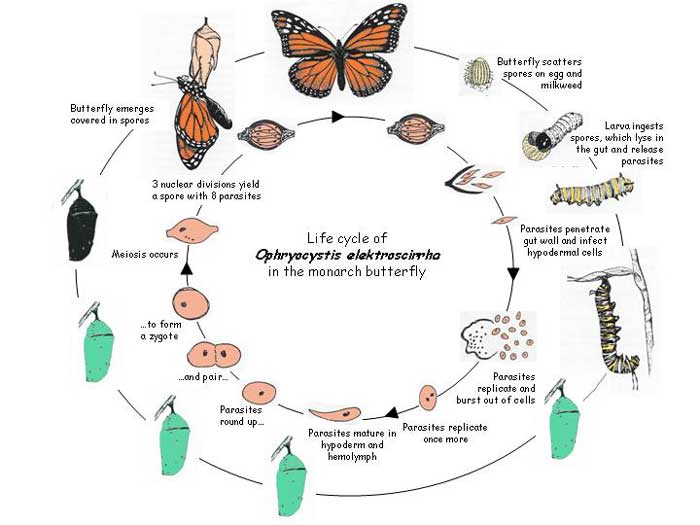OE is the abbreviation for Ophryocystis elektroscirrha (pronounced O-free-us-sis-tus electra-sceer-rah). It is a protozoan parasite that infects Monarchs (Danaus plexippus), Queens (Danaus gilippus), and Soldiers (Danaus eresimus).

OE can weaken caterpillars and cripple adult butterflies. Only rarely will OE kill a caterpillar, chrysalis, or butterfly. A parasite that is 100% dependent upon its host for its own life cannot kill the host or it will kill itself. OE is a master at keeping itself going through life cycle after life cycle in nature.
Life Cycle & Transmission of OE

The life cycle of OE is closely related to the life cycle of the monarch butterfly because OE can only reproduce inside the insect’s body. Infected females pass on the parasite to their offspring when they lay eggs by scattering dormant spores on their eggs and the surrounding milkweed. When a caterpillar hatches, it not only eats its egg shell and the milkweed, but also unintentionally consumes the OE spores.
Once eaten, the dormant spores move into the caterpillar’s midgut. During digestion, the spores break open and release the parasites, which move into the intestinal wall to the hypoderm. Here, OE reproduces asexually, meaning each OE parent cell divides in two new cells. This happens many times, greatly increasing the number of parasites.
Most of the damage done to the butterfly happens during the chrysalis stage. During this time, the OE parasite goes through sexual reproduction, further increasing the number of parasites in the monarch. About three days before the adult emerges from the pupa, spores will begin to form, which allow OE to survive outside of the monarch’s body. The spores can be seen as dark patches that appear through the integument (outside layer) of the pupa.
Infected adults emerge covered with spores. Once butterflies are infected, they do not recover. By the time adults emerge with parasite spores, all physical damage by the OE parasites has been done – the parasites do not grow or reproduce on the adults. The spores are inactive or dormant until they are eaten by another caterpillar. (Project Monarch Health https://www.monarchparasites.org/oe)
Signs of OE Infection
- Dark spots or blotches on the pupa: The spots are replicating spores, and they mostly form on the abdomen (but they can also form on the eyes, antennae, and wing veins).
- Deformed, crumpled wings: Adults that are heavily infected with OE are weak and often have difficulty emerging from the chrysalis. Some monarchs die before emerging. Others emerge, but are too weak to cling to the pupal case. They fall to the ground before fully expanding their wings. These severely deformed monarchs do not survive long.
- Smaller size: Even if the infection is only mild, these butterflies typically weigh less and have shorter forewing lengths than a healthy butterfly. Parasites also damage the cuticle, or outside layer of the monarch’s abdomen. This damage causes the butterfly to dry out and lose weight faster than normal. This is especially a problem if there is a shortage of nectar or water.
- Decreased flight endurance: Studies have shown that monarchs infected with OE cannot fly as far or as long as healthy butterflies. Often, infected monarchs die during the migration to Mexico simply because they don’t have the endurance.
Testing for OE
On adult butterflies, O.E. spores are dormant and reside on the outside of the body, usually the butterfly’s abdomen. You can’t see these dormant spores without observing a sample of the butterflies abdominal scales through a microscope.

Important Facts
- OE infects Monarchs in all North American populations of Monarch butterflies.
- The eastern migratory Monarchs have the lowest infection rate. Less than 8% of these butterflies are heavily infected with OE.
- More Monarchs have OE west of the Rocky Mountains. About 30% of the western migratory population is heavily infected with OE.
- The highest rate of OE in North America occurs in the nonmigratory Monarchs of South Florida. More than 70% of these Monarchs have OE infections.
- Only caterpillars can contract the disease but cannot give the disease to another caterpillar.
- Chrysalises have OE just under the cuticle (skin/hypoderm). It cannot contract or spread OE. The spores are inside the chrysalis.
- Between infections, OE survives as spores that are resistant to extreme environmental conditions.
- It has since been found in all other Monarch populations worldwide. Because of this world wide range, all indications are that this parasite has co-evolved with Monarchs.
Resources
- https://www.monarchparasites.org/oe
- https://en.wikipedia.org/wiki/Ophryocystis_elektroscirrha
- https://butterfly-fun-facts.com/oe-ophryocystis-elektroscirrha-monarch-butterfly/
- http://www.monarchs-and-milkweed.com/raising-oe-free-monarchs.pdf
